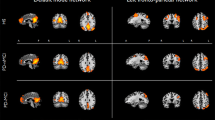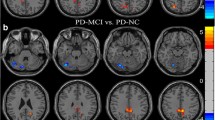Abstract
Background
Resting-state functional magnetic resonance imaging (rs-fMRI) was widely used as an effective tool in the diagnosis of neurodegenerative diseases. However, prior rs-fMRI studies reported inconsistent results for comparison between Parkinson’s disease (PD) and healthy controls (HC).
Methods
We searched studies published before December 2021 in databases (PubMed, Web of Science, and Google Scholar). An activation likelihood estimation (ALE) meta-analysis was made for functional changes in PD.
Results
The study finally included 25 studies (including 973 PD patients and 766 HC). PD patients showed reduced amplitude of low frequency fluctuations (ALFF) in the left superior temporal gyrus (STG), the left superior frontal gyrus (SFG), the left medial frontal gyrus (MFG), the left precuneus (PCUN), and the right lentiform nucleus, compared to HC. PD patients showed increased ALFF in the right SFG, the left superior parietal lobule (SPL), the left STG, the right fusiform gyrus, the left inferior temporal gyrus (ITG), and the right parahippocampal gyrus (PHG), compared to HC. PD patients showed reduced regional homogeneity (ReHo) in the right declive, the right MFG, the left culmen, and the left thalamus, compared to HC. PD patients showed increased ReHo in the right SFG, compared to HC. Additionally, PD patients showed reduced functional connectivity (FC) in the right posterior cingulate (PCG), compared to HC.
Conclusions
The present ALE analysis has confirmed functional deficits in motor-, emotion-, and cognition-related regions in PD. Deficits in these regions in rs-fMRI studies could play a role in early diagnosis of PD.





Similar content being viewed by others
References
Kalia LV, Lang AE (2015) Parkinson’s disease. Lancet (London, England) 386(9996):896–912
Global, regional, and national burden of Parkinson’s disease, (1990–20160) (2018) a systematic analysis for the Global Burden of Disease Study 2016. Lancet Neurol 17(11):939–53
Gu L, Zhang Z (2019) Exploring structural and functional brain changes in mild cognitive impairment: a whole brain ALE meta-analysis for multimodal MRI. ACS Chem Neurosci 10(6):2823–9
Li Y, Liang P, Jia X et al (2016) Abnormal regional homogeneity in Parkinson’s disease: a resting state fMRI study. Clin Radiol 71(1):e28-34
Choe IH, Yeo S, Chung KC et al (2013) Decreased and increased cerebral regional homogeneity in early Parkinson’s disease. Brain Res 1527:230–7
Yang H, Zhou XJ, Zhang MM et al (2013) Changes in spontaneous brain activity in early Parkinson’s disease. Neurosci Lett 549:24–8
Moher D, Liberati A, Tetzlaff J et al (2009) Preferred reporting items for systematic reviews and meta-analyses: the PRISMA statement. Annal Internal Med 151(4):264–9 w64
Laird AR, Robinson JL, McMillan KM et al (2010) Comparison of the disparity between Talairach and MNI coordinates in functional neuroimaging data: validation of the Lancaster transform. Neuroimage 51(2):677–683
Lancaster JL, Tordesillas-Gutierrez D, Martinez M et al (2007) Bias between MNI and Talairach coordinates analyzed using the ICBM-152 brain template. Hum Brain Mapp 28(11):1194–1205
Turkeltaub PE, Eickhoff SB, Laird AR et al (2012) Minimizing within-experiment and within-group effects in Activation Likelihood Estimation meta-analyses. Hum Brain Mapp 33(1):1–13
Wu T, Long X, Zang Y et al (2009) Regional homogeneity changes in patients with Parkinson’s disease. Hum Brain Mapp 30(5):1502–1510
Kwak Y, Peltier SJ, Bohnen NI et al (2012) L-DOPA changes spontaneous low-frequency BOLD signal oscillations in Parkinson’s disease: a resting state fMRI study. Front Syst Neurosci 6:52
Göttlich M, Münte TF, Heldmann M et al (2013) Altered resting state brain networks in Parkinson’s disease. PloS one 8(10):e77336
Skidmore FM, Yang M, Baxter L et al (2013) Reliability analysis of the resting state can sensitively and specifically identify the presence of Parkinson disease. NeuroImage 75:249–61
Wen X, Wu X, Liu J et al (2013) Abnormal baseline brain activity in non-depressed Parkinson’s disease and depressed Parkinson’s disease: a resting-state functional magnetic resonance imaging study. PLoS ONE 8(5):e63691
Zhang J, Wei L, Hu X et al (2013) Specific frequency band of amplitude low-frequency fl uctuation predicts Parkinson’s disease. Behav Brain Res 252:18–23
Hou Y, Wu X, Hallett M et al (2014) Frequency-dependent neural activity in Parkinson’s disease. Hum Brain Mapp 35(12):5815–5833
Luo C, Chen Q, Song W et al (2014) Resting-state fMRI study on drug-naive patients with Parkinson’s disease and with depression. J Neurol Neurosurg Psychiatr 85(6):675–683
Sheng K, Fang W, Su M et al (2014) Altered spontaneous brain activity in patients with Parkinson’s disease accompanied by depressive symptoms, as revealed by regional homogeneity and functional connectivity in the prefrontal-limbic system. PLoS ONE 9(1):e84705
Wei L, Zhang J, Long Z et al (2014) Reduced topological efficiency in cortical-basal ganglia motor network of Parkinson’s disease: a resting state fMRI study. PLoS ONE 9(10):e108124
Borroni B, Premi E, Formenti A et al (2015) Structural and functional imaging study in dementia with Lewy bodies and Parkinson’s disease dementia. Parkinsonism Relat Disord 21(9):1049–1055
Chen HM, Wang ZJ, Fang JP et al (2015) Different patterns of spontaneous brain activity between tremor-dominant and postural instability/gait difficulty subtypes of Parkinson’s disease: a resting-state fMRI study. CNS Neurosci Ther 21(10):855–866
Hu XF, Zhang JQ, Jiang XM et al (2015) Amplitude of low-frequency oscillations in Parkinson’s disease: a 2-year longitudinal resting-state functional magnetic resonance imaging study. Chin Med J 128(5):593–601
Luo C, Guo X, Song W et al (2015) Decreased resting-state interhemispheric functional connectivity in Parkinson’s disease. BioMed Res Int 2015:692684
Wu T, Ma Y, Zheng Z et al (2015) Parkinson’s disease-related spatial covariance pattern identified with resting-state functional MRI. J Cereb Blood Flow Metab 35(11):1764–1770
Zhang J, Wei L, Hu X et al (2015) Akinetic-rigid and tremor-dominant Parkinson’s disease patients show different patterns of intrinsic brain activity. Parkinsonism Relat Disord 21(1):23–30
Tinaz S, Lauro P, Hallett M et al (2016) Deficits in task-set maintenance and execution networks in Parkinson’s disease. Brain Struct Funct 221(3):1413–1425
Zhang JJ, Ding J, Li JY et al (2017) Abnormal resting-state neural activity and connectivity of fatigue in Parkinson’s disease. CNS Neurosci Ther 23(3):241–247
Zhou C, Zhong X, Yang Y et al (2018) Alterations of regional homogeneity in freezing of gait in Parkinson’s disease. J Neurol Sci 387:54 9
Hu J, Xiao C, Gong D et al (2019) Regional homogeneity analysis of major Parkinson’s disease subtypes based on functional magnetic resonance imaging. Neurosci lett 706:81–7
Li MG, Liu TF, Zhang TH et al (2020) Alterations of regional homogeneity in Parkinson’s disease with mild cognitive impairment: a preliminary resting-state fMRI study. Neuroradiology 62(3):327–34
Guo W, Jin W, Li N et al (2021) Brain activity alterations in patients with Parkinson’s disease with cognitive impairment based on resting-state functional MRI. Neurosci Lett 747:135672
Li M-G, Liu T-F, Zhang T-H et al (2020) Alterations of regional homogeneity in Parkinson’s disease with mild cognitive impairment: a preliminary resting-state fMRI study. Neuroradiology 62(3):327–34
Wang N, Edmiston EK, Luo X et al (2017) Comparing abnormalities of amplitude of low-frequency fluctuations in multiple system atrophy and idiopathic Parkinson’s disease measured with resting-state fMRI. Psychiatr Res Neuroimaging 269:73–81
Burciu RG, Ofori E, Shukla P et al (2015) Distinct patterns of brain activity in progressive supranuclear palsy and Parkinson’s disease. Mov Dis : Off J Mov Disord Soc 30(9):1248–1258
Puckett AM, Bollmann S, Poser BA et al (2018) Using multi-echo simultaneous multi-slice (SMS) EPI to improve functional MRI of the subcortical nuclei of the basal ganglia at ultra-high field (7T). Neuroimage 172:886
Sperling W, Ller MH (2011) Nucleus lentiformis–a new model for psychiatry? Med hypotheses 76(5):720–2
Petrella JR, Sheldon FC, Prince SE et al (2011) Default mode network connectivity in stable vs progressive mild cognitive impairment. Neurology 76(6):511–517
Pihlajamki M, Jauhiainen AM, Soininen H (2009) Structural and functional MRI in mild cognitive impairment. Curr Alzheimer Res 6(2):179–85
Yang Y, Raine A (2009) Prefrontal structural and functional brain imaging findings in antisocial, violent, and psychopathic individuals: a meta-analysis. Psychiatry Res 174(2):81–88
Goodale MA, Milner AD, Jakobson LS et al (1991) A neurological dissociation between perceiving objects and grasping them. Nature 349(6305):154–156
Grafton ST, Mazziotta JC, Presty S et al (1992) Functional anatomy of human procedural learning determined with regional cerebral blood flow and PET. J Neurosci Off Neurosci 12(7):2542–2548
Camicioli R, Moore MM, Kinney A et al (2003) Parkinson’s disease is associated with hippocampal atrophy. Mov Disord 18(7):784–790
George N, Dolan RJ, Fink GR et al (1999) Contrast polarity and face recognition in the human fusiform gyrus. Nat Neurosci 2(6):574–580
Sprengelmeyer R, Young AW, Mahn K et al (2003) Facial expression recognition in people with medicated and unmedicated Parkinson’s disease. Neuropsychologia 41(8):1047–1057
Middleton FA, Strick PL (2001) Cerebellar projections to the prefrontal cortex of the primate. J Neurosci 21(2):700–712
Funding
This study was supported by the National Natural Science Foundation of China (No. 81901108; 81801075), the Special fund for basic scientific research operating expenses of Southeast University (No. 2242019K40256), Natural Science Foundation of Jiangsu Province (BK20180379), and Innovative Talents of Jiangsu Province Fundation.
Author information
Authors and Affiliations
Corresponding author
Ethics declarations
Ethical approval
Not applicable.
Informed consent
Not applicable.
Competing interests
The authors declare no competing interests.
Additional information
Publisher's note
Springer Nature remains neutral with regard to jurisdictional claims in published maps and institutional affiliations.
Supplementary Information
Below is the link to the electronic supplementary material.
Rights and permissions
About this article
Cite this article
Gu, L., Shu, H., Xu, H. et al. Functional brain changes in Parkinson’s disease: a whole brain ALE study. Neurol Sci 43, 5909–5916 (2022). https://doi.org/10.1007/s10072-022-06272-9
Received:
Accepted:
Published:
Issue Date:
DOI: https://doi.org/10.1007/s10072-022-06272-9




